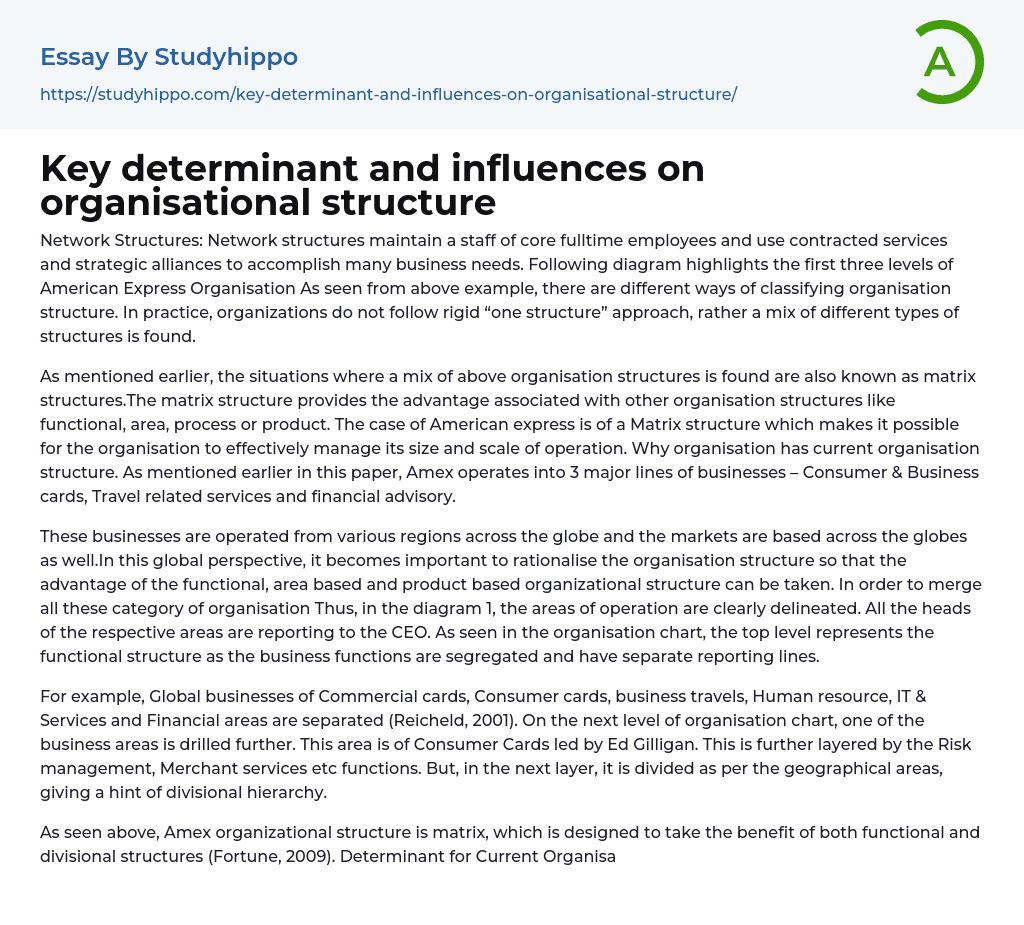

Key determinant and influences on organisational structure Essay Example
Network Structures: Network structures maintain a staff of core fulltime employees and use contracted services and strategic alliances to accomplish many business needs. The following diagram showcases the first three levels of the American Express Organisation. As seen from the above example, there are various ways of categorizing organization structure. In practice, organizations do not adhere strictly to a single structure approach. Instead, they employ a combination of different types of structures. These situations, also known as matrix structures, offer the advantages associated with other organization structures such as functional, area, process or product.
The case of American Express involves a Matrix structure that allows the organization to effectively manage its size and scale of operations. The current structure of the organization is determined by the reasons mentioned earlier in this paper. American Express operates in three major line
...s of business, namely Consumer & Business cards, Travel related services, and financial advisory. These businesses are run from different regions worldwide, and their markets are also based globally. In this global context, it is crucial to streamline the organization's structure to take advantage of the benefits offered by functional, area-based, and product-based organizational structures.
According to diagram 1, the various categories of organization are merged. The CEO oversees all the heads in their respective areas of operation. The organization chart shows that the top level represents a functional structure, with separate reporting lines for different business functions. This includes divisions for global businesses such as Commercial Cards, Consumer Cards, Business Travels, Human Resources, IT ; Services, and Financial areas (Reicheld, 2001).
On the next level of the organisation chart, there is a focus on the Consumer Cards business area
led by Ed Gilligan. This is then divided into various functions such as Risk management and Merchant services. However, in the following layer, there is a division based on geographical areas, indicating a divisional hierarchy. As mentioned before, the Amex organizational structure is a matrix that combines both functional and divisional structures to maximize their benefits (Fortune, 2009).
Various factors are determinant for the current organisational structure. These factors include strategy, size, technology, change, environment, and culture. All of these factors have a significant influence on the structure adopted by an organisation. American Express is an example where all of these factors played a significant role in determining its structure.
When it comes to strategy, there are several important aspects of different organisational structures. Functional structures group people with similar skills together, while divisional structures group people based on products, customers, or locations. Matrix structures combine both functional and divisional structures, and team structures involve using both permanent and temporary teams. Network structures heavily rely on strategic alliances.
Functional structures have various advantages, including economies of scale that lead to efficient utilization of human resources. It has been observed that functional experts excel at solving technical problems.
Functional structure in Amex has several advantages. Firstly, training within functions helps in developing skills. Additionally, each function offers career paths. These benefits are effectively utilized when the functional structures are implemented at the highest level in the organization. However, the primary challenge of functional structure is the lack of communication and coordination among different functional organizations. This results in the problem of financial chimney's, as displayed in the diagram below (Erlingsdottir, 2005). To address this issue at the middle management layer,
Amex has implemented a divisional organizational structure.
The divisional organizational structure offers several advantages, such as focused expertise on special products, customers, and regions. It also enables better coordination across functions within divisions and enhances accountability for product or service delivery. Additionally, it provides flexibility to adjust the size of the organization as conditions change.
- Being A Leader essays
- Servant Leadership essays
- Leadership Experience essays
- Leadership Qualities essays
- Board Of Directors essays
- Brand Management essays
- Business Ethics essays
- Business Management essays
- Change Management essays
- Comparative Analysis essays
- Decision Making essays
- Dispute Resolution essays
- Knowledge Management essays
- Leadership essays
- Leadership and Management essays
- Manager essays
- Operations Management essays
- Performance Management essays
- Product Management essays
- Project Management essays
- Quality Management essays
- Risk essays
- Risk Management essays
- Scientific Management essays
- Stress Management essays
- supply chain management essays
- Time Management essays
- Total Quality Management essays
- Collective Bargaining essays
- Corporate Culture essays
- Hard Work essays
- Job Satisfaction essays
- Organizational Culture essays
- Organizational Structure essays
- Sweatshops essays
- Workforce essays
- Working capital essays
- Working Class essays
- Working Time essays
- Workstation essays
- Accounting essays
- Andrew Carnegie essays
- Automation essays
- Business Cycle essays
- Business Intelligence essays
- Business Model essays
- Business Operations essays
- Business Software essays
- Cooperation essays
- Cooperative essays



